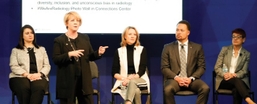
Pictured left to right: Dania Daye, MD, PhD, Mary C. Mahoney, MD, Geraldine McGinty, MD, Paul J. Rochon, MD and Carolyn C. Meltzer, MD.
In the Discovery Theater on Wednesday, Dania Daye, MD, PhD, led a panel of radiology leaders in a discussion highlighting the value of diversity and inclusion in radiology.
In opening remarks, RSNA Board Chair Mary C. Mahoney, MD, recognized the progress RSNA has made in elevating women in particular to leadership roles.
"I am truly honored to be a leader in an organization that does so much to support women and diversity and inclusion," said Dr. Mahoney, noting that RSNA first elevated a woman to the role of president in 1995 with six to follow, and that 33% of RSNA committee chairs and faculty are women.
Referencing the call to embrace diversity, Geraldine McGinty, MD, ACR Board chair, said, "It starts with expanding our idea of what a leader looks like." She emphasized the critical importance of empowering diverse voices in the field.
Speaking about the pipeline, Paul J. Rochon, MD, said, "We need to dispel the myth that radiologists are isolated from patient interactions—the invisibility factor." He highlighted statistics demonstrating largely single digit percentage representation of underrepresented minorities across all career levels and subspecialties in radiology. (Read more about Dr. Rochon's session on Diversity in the Radiology Workforce.)
Finally, ongoing retention and promotion processes free from unconscious bias are required to ensure talented professionals with diverse perspectives make it through that pipeline into leadership.
RSNA Board member Carolyn C. Meltzer, MD, described being stunned by gender aggression as an assistant professor when she noticed faculty leaders would introduce male colleagues formally as "Dr. Smith," then in the same moment introduce women by their first names. She noted that research shows this happens often, and that it imposes a devaluing of those individuals.
"We have to think about every part of how people advance and look at bias at each step in the meritocracy," Dr. Meltzer said. She discussed documents where bias appears, including letters of recommendations—which use different language to describe men and women—and grant proposal reviews, where women are more likely to be characterized as part of a team while men tend to be called pioneers. This is important, she stressed, because those different words translate to a difference in funding levels.
"We need allies," she said, acknowledging the diversity of the people in the room, "We need everybody embracing this if we are going to be successful."
Dr. Daye asked the panel for tips to address the noted microaggressions. Dr. Meltzer suggested addressing the situation in the moment from an appreciation and inquiry standpoint, seeking to understand rather than being confrontational.
"I would add that amplification is key," Dr. Mahoney said. "We should speak up and bring attention back to a colleague's point when she has been passed over. We need to do that for each other."

